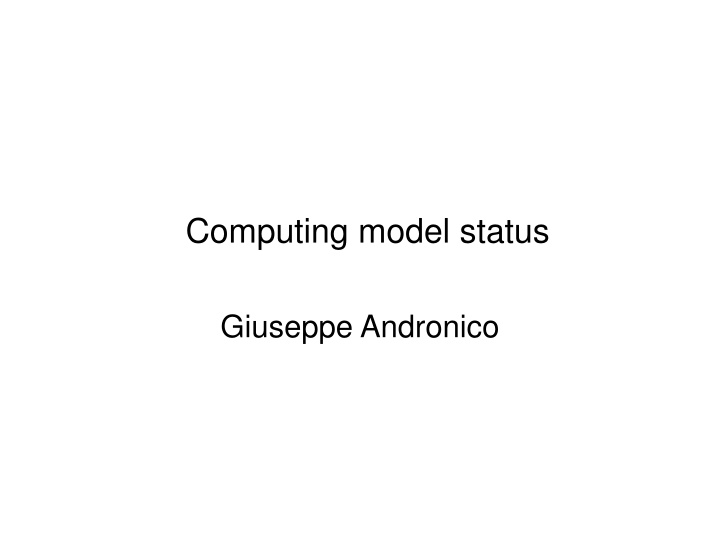
JUNO Computing Model and Collaboration
Explore the intricate details of the JUNO computing model and collaboration, including data producers, material choices, detector designs, calibration systems, and more. Learn about the offline software framework, data centers, and the handling of massive amounts of data output.
Download Presentation

Please find below an Image/Link to download the presentation.
The content on the website is provided AS IS for your information and personal use only. It may not be sold, licensed, or shared on other websites without obtaining consent from the author. If you encounter any issues during the download, it is possible that the publisher has removed the file from their server.
You are allowed to download the files provided on this website for personal or commercial use, subject to the condition that they are used lawfully. All files are the property of their respective owners.
The content on the website is provided AS IS for your information and personal use only. It may not be sold, licensed, or shared on other websites without obtaining consent from the author.
E N D
Presentation Transcript
Computing model status Giuseppe Andronico
Groups in JUNO Description Data producer Design, material choice, optimization, deployment Central detector No Set of detectors to exclude uninteresting signals Veto detector No Design, production and management of liquid scintillator Liquid scintillator No JUNO calibration system, several sources, mechanical part design and implementation Calibration system Yes Design, test and production of LPMT and electronics Wait trigger signal to write to disk Large PMT Electronics Yes Design, test and production of SPMT and electroncs Wait trigger signal to write to disk Small PMT system Yes Select meaningfull physical events Trigger No Reconstruct event from data passed trough the firewall and select events to write on disk Online event reconstruction No Framework, reconstruction, analysis, and all it is offline Offline No
JUNO Collaboration ArmeniaYerevan Physics Institute CzechCharles U. ChinaIMP-CAS BelgiumUniversit libre de Bruxelles FinlandUniversity of Oulu ChinaJilin U. ItalyINFN-Perugia BrazilPUC FranceAPC Paris ChinaJinan U. ItalyINFN-Roma 3 BrazilUEL FranceCENBG ChinaNanjing U. LatviaIECS ChilePCUC FranceCPPM Marseille ChinaNankai U. PakistanPINSTECH (PAEC) ChileUTFSM FranceIPHC Strasbourg ChinaNCEPU RussiaINR Moscow ChinaBISEE FranceSubatech Nantes ChinaNUDT RussiaJINR ChinaBeijing Normal U. GermanyZEA FZ Julich ChinaPeking U. RussiaMSU ChinaCAGS GermanyRWTH Aachen U. ChinaShandong U. SlovakiaFMPICU ChinaChongQing University GermanyTUM ChinaShanghai JT U. TaiwanNational Chiao-Tung U. ChinaCIAE GermanyU. Hamburg ChinaSYSU TaiwanNational Taiwan U. ChinaCUG GermanyIKP FZ J lich ChinaTsinghua U. TaiwanNational United U. ChinaDGUT GermanyU. Mainz ChinaUCAS ThailandNARIT ChinaECUST GermanyU. Tuebingen ChinaUSTC ThailandPPRLCU ChinaECUT ItalyINFN Catania ChinaU. of South China ThailandSUT
Data centers Network (Gb/s) 10 100 100 10 10 Storage (PB) 5+15 70+30 80+33 n.d. 11+12 Computing (core) 18,000 38,000 40,000 n.d. 17,000 Storage in format tape storage + disk storage
Computing model Data Offline Software Framework
Computing model: data Data output from electronic: 1 EB/year Generic view Given the expected number of events per day we aspect a cut in data output to 2 PB/year. JUNO-doc-4766-v1
Computing model: data upper limit 2PB/year 0.6 PB/year Raw data Calibration data* Data type and volume order of 200TB/year order of 100TB/year order of TB/year Rec data Sim data Analysis data upper limit 3PB disk/year Total resources requirements Storage 12000 CPU cores Computing Data quality monitoring is under study+ * JUNO-doc-4787-v3 + JUNO-doc-4789-v2
Computing model: data storage and flows Output from Central Detector go trough trigger and filtering CD site Data copied from Kaiping to IHEP CD to IHEP At IHEP recent data are stored on disk and then moved to tape IHEP At least a backup copy, perhaps 2, in Europe IHEP to Europe In Europe recent data on disk, then moved on tape Data in Europe used for analysis and for reconstruction Europe Data management with file catalog and book-keeping Find data file
Computing model: raw data JUNO-doc-4805-v1 Proposed raw data naming Daq.RunNumber.StreamType.StreamName.FileTag.FileTime.FileSequence. dat For example: daq.10001.Physics.CD.Neutrino.20190606123025.0001.dat StreamType: Physics/CDCalib/WPCalib StreamName: Merged/CD/WP/SPMT/TT/MM/SN FileTag Test/Neutrino/SrcMoving/InPosition FileTime yyyymmddhhmmss FileSequence 0001
Computer model: offline Software framework Largely based on SNIPER, developed at IHEP, with Root, Geant4, CLHEP, GCCXML and other libraries Versioning and revision system: trac + svn Build system for framework: cmake Reconstruction and analysis Reconstruction leaded from IHEP, distributed between the several data centres with a production tool Analysis Bound to groups working on different physical problems; for example Inverse Beta Decay and Mass Ordering Geo neutrinos Solar neutrinos Atmospheric neutrinos Several groups interested to same data file for different analysis Simulation Based on software framework Several tools for different physical problems and detector parts






















